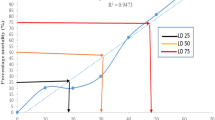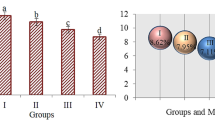Abstract
THE radiosensitivity of various species of plants has been investigated for many years1,2. Much recent work has been concerned with attempts to discover if there is some common cellular feature which might serve as an index of radiosensitivity. In general, the nucleus (or its components) has been considered as the primary object determining radiosensitivity3–7. One method of investigation has been to irradiate a number of different species and then to correlate the responses of the irradiated plants with inherent particular nuclear parameters of apical meristem cells of unirradiated control plants. In general, plants with the smaller nuclei have been found to be more resistant to radiation than those plants with the larger nuclei. Indeed, where the species being compared differed in chromosome number, Sparrow et al.8 have shown that the quotient of the nuclear volume divided by the chromosome number (the interphase chromosome volume) is a more accurate index of radio-sensitivity than nuclear volume alone. Thus chromosome number is important in determining radiosensitivity where variation in numbers exists.
This is a preview of subscription content, access via your institution
Access options
Subscribe to this journal
Receive 51 print issues and online access
$199.00 per year
only $3.90 per issue
Buy this article
- Purchase on Springer Link
- Instant access to full article PDF
Prices may be subject to local taxes which are calculated during checkout
Similar content being viewed by others
References
Isotopes Rayonnements Agriculture, Etude Bibliographique No. 1 (Saclay, France, 1962).
Sparrow, A. H., et al., Bibliography on the Effects of Ionizing Radiations on Plants, 1896–1955, BNL 504 (L–103) (Brookhaven Nat. Lab., Upton, N.Y., 1958).
Zirkle, R. E., J. Cell. Comp. Physiol., 2, 251 (1932).
Henshaw, P. S., Amer. J. Cancer, 33, 258 (1938).
Osborne, T. S., and Lunden, A. O., Science, 145, 710 (1964).
Sparrow, A. H., Ann. N.Y. Acad. Sci., 51, 1508 (1951).
Sparrow, A. H., The Role of the Cell Nucleus in Determining Radiosensitivity, Brookhaven Lec. Ser. No. 17, BNL 766(T–287) (Brookhaven Nat. Lab., Upton, N.Y., 1962).
Sparrow, A. H., et al., Science, 141, 163 (1963).
Miller, M. W., The Bryologist (in the press).
Sparrow, A. H., et al., Rad. Bot., 3, 169 (1963).
Lea, D. E., Actions of Radiations on Living Cells, second ed. (Univ. Press, Cambridge, 1962).
Author information
Authors and Affiliations
Rights and permissions
About this article
Cite this article
MILLER, M., SPARROW, A. Relationship between Nuclear Volume and Radiosensitivity of Different Cell Types in Gemmæ of Marchantia polymorpha L.. Nature 204, 596–597 (1964). https://doi.org/10.1038/204596a0
Issue Date:
DOI: https://doi.org/10.1038/204596a0
This article is cited by
Comments
By submitting a comment you agree to abide by our Terms and Community Guidelines. If you find something abusive or that does not comply with our terms or guidelines please flag it as inappropriate.



